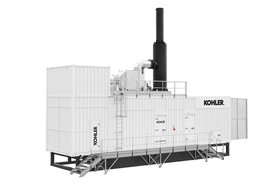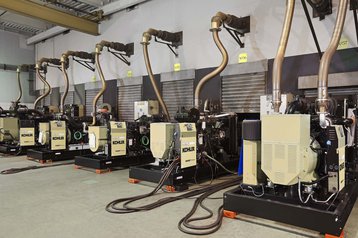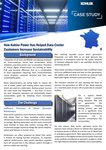The data center market in Southeast Asia remains buoyant but environmental concerns are increasingly shaping government policies.
Data center operators are responding with multiple decarbonization initiatives and innovations in diesel engine design are contributing significantly to emissions reductions.
The Southeast Asia data center market remains buoyant
Strong market demand continues to drive rapid growth in the data center market across Southeast Asia, with latest research forecasting an incremental $12.6 billion over the period 2020 to 2025. But this headline figure masks significant variability in growth within individual countries, dictated by factors such as government regulation and land availability.
The post-pandemic trend towards hybrid working is creating investment opportunities as performance requirements of evolving cloud solutions demand that additional data centers be built closer to the end user.
The ongoing globalization of the region’s market is having a knock-on effect on demand for the fuel used by the mission critical equipment, which provides data center backup power. Concerns over the stability of supply due to geo-political events, along with a drive towards global economies of scale are behind a move from gas turbines to diesel generators.
Sustainability and the diesel generator set
This trend towards increasing use of diesel gensets may seem counter-intuitive, given the increased focus on sustainability but, although alternative technologies are beginning to emerge, the diesel generator remains the most reliable tool when the power goes down.
It may only be used infrequently, but decarbonization initiatives by the data center operators are placing the diesel generator in the spotlight and manufacturers, such as Kohler, are focusing their energy and investments on making it greener. Advancements in alternative fuels along with in-cylinder and after treatment technologies are contributing to ongoing reductions in emissions from diesel generators.
While capitalizing on this demand, the region’s tier I countries, led by Singapore, are using strict decarbonization regulations to encourage technological innovation, driven by commitments to emissions targets. Pressure on land availability in Singapore is also feeding into regulations, as reflected by a trend towards smaller, lower capacity infrastructures.
Although Singapore’s position as the regional data center powerhouse is undisputed, the big, global tech companies are spreading their investment risk across the region, investing in other tier I countries, including Japan, South Korea, Hong Kong and Taiwan, whose markets remain buoyant.
The trend is also extending to tier II countries, such as Indonesia, Malaysia, Thailand and the Philippines, as Western organizations recognize the geographical gateway opportunities presented by these countries.
In-cylinder enhancements improve engine efficiencies
Thanks to digital tools such as computer-aided engineering and computational fluid dynamics, designers of modern engines, such as the KOHLER SD series, are able to finely model engine behavior and optimize performance.
The resulting improvements in engine burn efficiency significantly reduce the effects of wet stacking, and further innovations such as common rail fuel injection and engine monitoring systems adjust the engine combustion process according to cylinder temperature and emissions.
After-treatment solutions treat exhaust gases to further reduce pollutants
While in-cylinder technologies can significantly reduce pollutants such as nitrogen oxide emissions (NOx) and particulate matter (PM), they cannot eliminate them totally, so after treatment techniques must be employed. After-treatment systems are add-ons to the diesel engine, and include diesel oxidation catalysts (DOC), diesel particulate filters (PDF), and selective catalytic reduction (SCR).
DOC devices reduce carbon monoxide, hydrocarbon, and the soluble organic fraction (SOF), of diesel particulates by using heat and catalyst materials that create oxidizing chemical reactions resulting in the production of carbon dioxide (CO2) and water (H2O).
DOCs are relatively low cost, easy to install and require little maintenance but usually need to be used in combination with another device, such as a PDF or SCR, since they are not effective in reducing levels of PM or NOx.
DPFs use a ceramic substrate to trap the PM from the exhaust gases. DPFs require regular maintenance, requiring regular generation to burn off the trapped PM. This regeneration process increases back pressure on the engine and also needs a minimum exhaust temperature, leading in turn to the need for a heat additive and, potentially, a load bank.
SCR reduces NOx emissions by injecting diesel exhaust fluid (DEF) into the exhaust stream. The NOx reacts with ammonia in the DEF, with the reaction rate being increased by a metal-based catalyst. SCR is the best commercially available technology for reducing NOx emissions but requires careful design and installation and the DEF fluid requires careful handling and storage.
HVO is a promising, low carbon, alternative to diesel
Alongside these engine refinements, alternative, renewable fuels, such as hydrotreated vegetable oil (HVO), offer additional opportunities for emissions reductions.
A second-generation biofuel, HVO is a direct replacement for regular diesel, giving up to 90 percent reductions in carbon emissions. Engines do not need any modifications in order to use HVO and the fuel can be mixed in any proportion with regular diesel.
Manufactured from food waste, HVO does not require valuable land space, unlike previous generations of biofuel, and can be stored for several years without degradation.
A growing number of diesel engines, including Kohler's KD Series, have been tested and certified to operate with HVO100 and the availability of this fuel is steadily increasing as global production capacity increases.
Modern technologies will gradually displace the diesel engine from the data center
While these innovations are having a positive impact on the carbon emissions of the diesel generator, data center operators have begun to trial new technologies as alternative sources of backup power.
A recent trial by Microsoft, for example, successfully powered a bank of Azure cloud servers for 48 hours from a 250-kilowatt hydrogen fuel cell. Since most power outages last less than 48 hours, this trial has proven the concept of using fuel cells as backup power source.
Batteries are another leading contender for power backup, particularly in Southeast Asia, where local manufacturing capacity has been developed to serve a strong automotive sector. A number of hyperscale operators, including Google are assessing the feasibility of using megawatt-scale battery deployments, as generator replacements.
While batteries are a promising solution, particularly since lithium-ion prices have fallen dramatically in recent years, various challenges remain to be overcome before battery systems can be scaled to meet the challenges of the large data center.
In the short term, neither fuel cells nor batteries are able to match the convenience and energy density of the diesel generator.
As research and development efforts continue, however, and the pressure to decarbonize data centers grow, there is no doubt that cleaner technologies will eventually supplant the diesel generator as a viable source of backup power.
In the meantime, though, ongoing investments by manufacturers such as Kohler are ensuring that the diesel generator remains a viable source of backup power while minimizing its impact on data center emissions.
More from Kohler
-

Sponsored How to generate more sustainable backup power
For data center operators looking to improve sustainability, without compromising on capabilities, the answer may be backup engines that can run on recycled vegetable oils, says Kohler’s Jacky Pluchon
-

The anxiety surrounding backup power
Is it more important now than ever?
-

Sponsored Not so siloed
A look ahead at the convergent future of digital infrastructure





